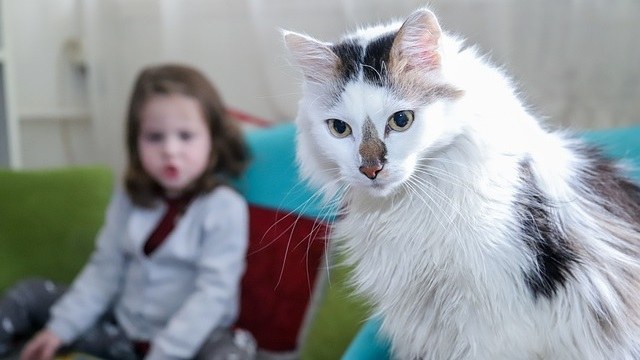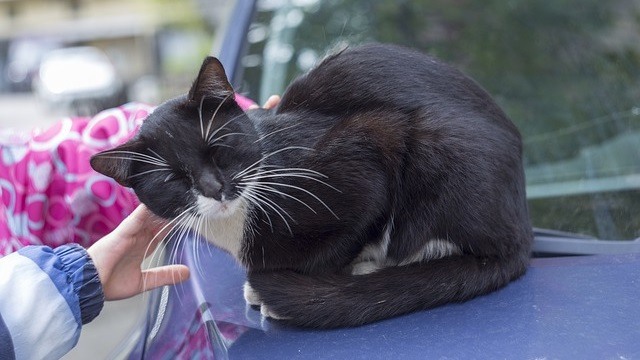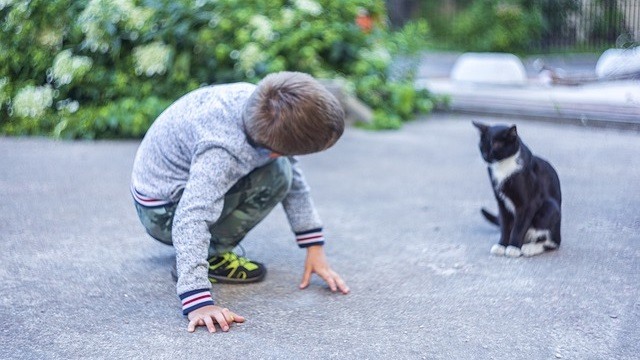The relationship between kids and cats can be a celebratory union that leads to a deep lifetime friendship. However, this interaction can be fraught with complication and even physical struggle, if not handled well. Children often fail to read distress signs from cats, making scratches and bites highly likely. No wonder why cats, kids and parents usually get upset and frightened during the first bonding attempts.
Proactivity and preparation will make bonding easier, while reducing stress and unwanted behaviors, so that the entire family can live in harmony. But to be proactive, effective and successful, cat parents need to acquire knowledge on this matter and to adopt some basic procedures.
Make a good first impression

Once your cat has had time to explore each room of the house by themselves – and this can take a while – ask the children to sit down calmly and quietly in the room the cat is most familiar with. At this stage, the kids should ignore the cat and only interact if the cat takes the initiative. Treats are great to catch some cats’ attention and build their trust, and kids are usually delighted to use them.
There are two golden rules at this point:
- Kids should only pet the cat if the cat voluntarily approaches them.
- The cat must be able to get away safely if they feel like it.
Build up the amount of time spent together

Gradually build up the amount of time your cat and children spend together. Avoid rushing things and allow for both of them to get to know each other first without any physical interaction.
Playing with toys may work as an ice breaker, as usually both kids and cats enjoy it. However, it should be ceased right away in case the kids get too excited or noisy. Cats do not handle noise that well, and will need some time and space to pull themselves together.
First impressions have a huge weight on the quality of the relationship, so go over these stages with a calm and positive mindset.
Basics on how to caress a cat

Once your kid is old enough to understand that touching the cat requires some wisdom, it’s time to tell them where a cat should be caressed.
- On the base of chin, especially where the jawbone connects to the skull
- On the base of the ears
- On the cheeks behind the whiskers
- On the base of the tail
It’s important for kids to understand right from the beginning that a cat’s tail and tummy are out of boundaries and should be avoided. The great majority of kittens do not like being touched there! Even if they tolerate it and do not react, that does not mean that they are enjoying the moment.
Bear in mind that every cat is different, and what works best for most, might not be true for your own tiny tiger.
What an uncomfortable cat looks like

Teaching your kids how to spot the signs that the cat is uncomfortable goes a long way towards a safe interaction. After all, if they learn how to speak cat-language, it will be much less likely for them to be bitten or scratched.
- Look at the ears. When cats are fearful, upset or getting defensive, their ears usually get tucked tight towards the head or neck, or look like wings held out to the side (“airplane ears”).
- Check the tail. When it’s wagging, the cat is irritable and upset, and is not in a friendly state for interaction or stroking. It’s sometimes difficult for people to realize this, especially because in dogs, a wagging tail means exactly the opposite.
- Assess the entire body. Postures like the “Halloween cat pose” – arched back, tail up, standing on tiptoes, ears back – and a puffed-up posture indicate that the cat is very anxious.
- Hear what the cat has to say. Anxiety can be translated into growling, yowling, hissing or spitting.
- Panting, showing teeth, snapping and biting are obvious signs of distress.
What if the cat is unknown?

In these cases, the course of events can be tricky. Feral cats tend not to approach and will only react aggressively if they feel totally trapped. Generally speaking, no cat chooses to attack unless there is no other way to handle the stressful trigger. But when the cat belongs to someone, like a friend or family member, things may get more complicated to handle… As sometimes the cat’s boundaries are not fully taken into consideration.
Kids are fast learners, and will quickly adopt the right posture if taught well. So here are the messages any parent and pet parent should convey to the children:
- Always ask
Always ask the cat parent if you can pet the cat first. You can also ask if they like to be petted in any certain manner, or part of the body. Getting to know the red lines before engaging in an interaction will be of great help!
- Approach gently
Kneel or squat and extend the index finger or the hand at the cat’s nose level. Cats are territorial and explore their world through scent. Allow the cat to lean forward and examine your scent. Do not wiggle your fingers, make sudden moves or speak in an elevated voice. Just quietly hold your position and wait.
- Take the cat’s lead
If the cat wants to interact, they will most certainly rub their cheek or head against the extended finger or hand. Do not forget to take a cue from the tail! If it’s pointed upwards, the cat is pleased, while if it’s horizontal to the ground, they’re feeling neutral. Either way, those are positive postures.
- Be gentle
Do not be too harsh when petting. Cats in general like a gentle cuddle, especially the ones that are unfamiliar with you.
- Read the body language
Always keep a close eye on the kitty’s body language while greeting and petting. It can change suddenly, even if the cat was enjoying the interaction in the first place.
Let them have their own space

Last but surely not least, whether at your place or a friend’s place, the household cat must have access to a child-free area. Use baby gates, or create spaces up high where the cat can hide but still have access to their basic needs (like food and water). This will help them to enjoy interactions much better and to settle much quicker.
A healthy relationship between kids and cats starts being built on the same principles as when dealing with any other animal. The more calm and patient kids are around cats, the better the chances of establishing a friendly cat-child relationship. Respect means everything, for humans and cats alike. Let’s teach our children well and pave the way for feline friendships! As always, Maven’s vet team is here to help you through this journey in case you need any guidance.
Maven is all about proactive pet care. Be your best friend’s best friend by giving them 24/7, high-quality, industry-leading vet care to improve their mental health, physical health and more. No more frantic googling or unneeded stressful visits to the vet – Maven helps you save hundreds while also ensuring your pet lives the best life possible. Get your kit now!



